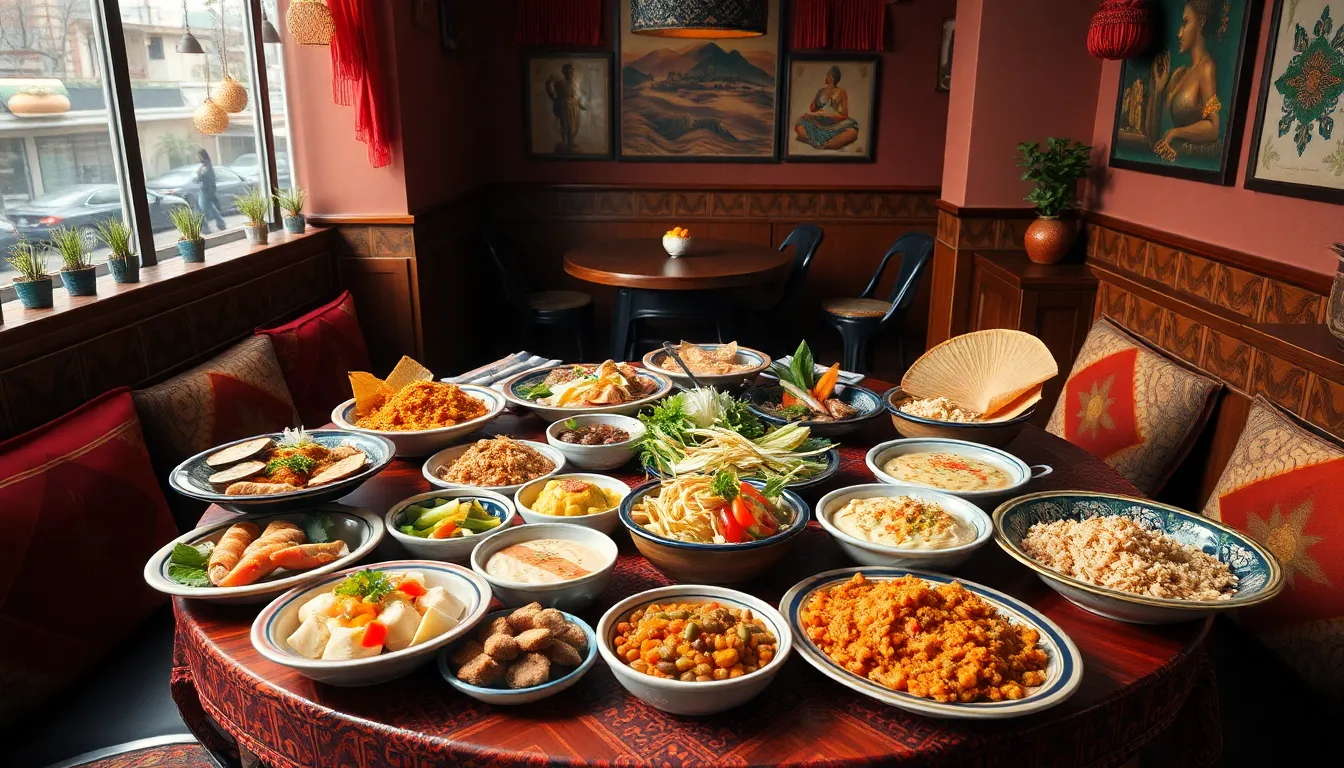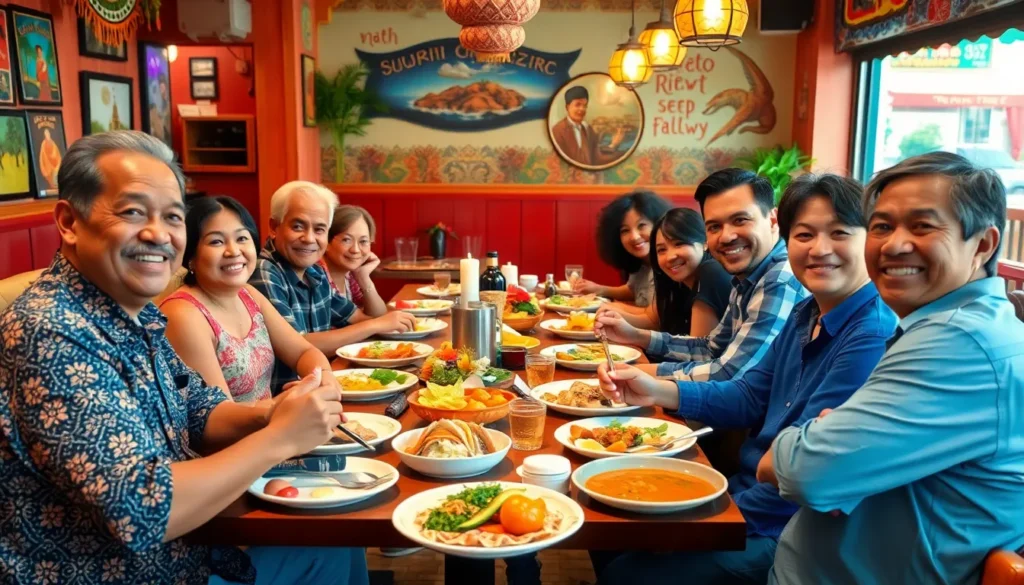Exploring ethnic restaurants opens a world of flavors and traditions that reflect diverse cultures. These culinary gems offer more than just food; they provide a unique experience that transports diners to different corners of the globe. From the spicy aromas of Indian curry to the delicate notes of Japanese sushi, each dish tells a story steeped in history and heritage.
Dining at an ethnic restaurant is an adventure for the senses. It’s not just about satisfying hunger; it’s about discovering new tastes and learning about the customs that shape each cuisine. Whether someone is a seasoned food lover or a curious newbie, ethnic restaurants offer something for everyone, making them a vital part of the culinary landscape.
Table of Contents
ToggleWhat Are Ethnic Restaurants?
Ethnic restaurants serve food that reflects the culinary traditions of specific cultural groups. They represent various global cuisines, such as Italian, Mexican, Thai, Indian, and Ethiopian, among others. These establishments create a platform for cultural exchange, allowing diners to experience flavors and cooking methods unique to each tradition.
Ethnic restaurants often emphasize authentic recipes, allowing patrons to taste dishes prepared using traditional techniques. Menu items typically include region-specific ingredients and spices, contributing to their distinctive flavors. Many ethnic restaurants incorporate elements of their cultures in decor, ambiance, and service styles, enhancing the dining experience.
These restaurants cater to a diverse clientele, attracting both adventurous eaters and individuals seeking comfort from familiar tastes. Ethnic cuisine provides an opportunity to celebrate diversity while fostering understanding and appreciation of different cultures. Eating at an ethnic restaurant not only satisfies hunger but also offers insights into the histories and customs behind various culinary practices.
Ethnic restaurants contribute significantly to the food landscape, promoting regional specialties and lesser-known dishes. They encourage a sense of community by supporting local growers and suppliers who provide authentic ingredients. Many ethnic establishments participate in cultural events, offering special menus that showcase seasonal or holiday-specific fare.
Ethnic restaurants serve as culinary ambassadors for their respective cultures, enriching the dining scene with unique experiences and flavors, and inviting everyone to discover the diversity of global cuisines.
Popular Types of Ethnic Cuisines

Ethnic cuisines showcase the unique flavors and traditions of their respective cultures. Each type offers distinct dishes and cooking techniques that reflect the heritage and preferences of the people.
Asian Cuisine
Asian cuisine encompasses a variety of flavors and ingredients from countries like China, Japan, Thailand, and India. Popular dishes include:
- Sushi: A Japanese dish featuring vinegared rice, raw fish, and vegetables.
- Dim Sum: A selection of small, flavorful dishes commonly served in Chinese cuisine.
- Curry: A staple in Indian cuisine, with diverse spices and ingredients creating rich, complex flavors.
- Pho: A traditional Vietnamese noodle soup made with broth, herbs, and meat.
Asian restaurants often emphasize fresh ingredients and bold flavors, making them a favorite among adventurous eaters.
Latin American Cuisine
Latin American cuisine highlights the diverse culinary traditions of Central and South America. Well-known dishes include:
- Tacos: Soft or hard tortillas filled with various ingredients like meat, beans, and vegetables.
- Ceviche: A dish made from raw fish cured in citrus juices, popular in coastal regions.
- Empanadas: Stuffed pastries baked or fried, filled with meat, cheese, or vegetables.
- Arepas: Cornmeal patties filled with meats, cheese, or avocados, especially in Colombia and Venezuela.
Restaurants serving Latin American cuisine often focus on vibrant flavors and communal dining experiences.
Mediterranean Cuisine
Mediterranean cuisine draws from the culinary traditions of countries bordering the Mediterranean Sea, such as Greece, Italy, and Turkey. Common dishes include:
- Hummus: A creamy dip made from chickpeas, often served with pita bread.
- Falafel: Deep-fried balls of ground chickpeas or fava beans, commonly found in Middle Eastern cuisine.
- Pasta: An Italian staple, available in numerous shapes and served with diverse sauces.
- Moussaka: A layered casserole featuring eggplant, ground meat, and béchamel sauce, iconic in Greek cuisine.
Mediterranean restaurants typically focus on healthy, fresh ingredients and emphasize communal dining.
African Cuisine
African cuisine consists of diverse flavors and ingredients, reflecting the continent’s many cultures. Key dishes include:
- Jollof Rice: A popular West African dish made with rice, tomatoes, and spices.
- Bunny Chow: A South African dish featuring curry served in a hollowed-out loaf of bread.
- Injera: A sourdough flatbread from Ethiopia, served with various stews and vegetables.
- Moroccan Tagine: A slow-cooked stew named after the pot, featuring meats or vegetables seasoned with spices.
African restaurants often highlight regional cooking methods and offer unique flavors, presenting an opportunity to explore the continent’s rich culinary heritage.
The Experience of Dining at Ethnic Restaurants
Dining at ethnic restaurants immerses patrons in the traditions and flavors of various cultures. Each visit delivers a unique experience that blends culinary adventure with cultural education.
Authenticity of Flavor
Authentic flavors define the dining experience at ethnic restaurants. Chefs often use traditional recipes and time-honored cooking techniques to preserve the integrity of their cuisine. Ingredients sourced from specific regions enhance the authenticity, reflecting the unique culinary identity of each culture. For example, Italian restaurants emphasize fresh pasta made from local grains, while Indian establishments rely on spices imported directly from the subcontinent. This commitment to authenticity ensures that diners encounter rich, true-to-culture flavors. Ethnic restaurants also invite guests to explore dishes that may not be widely available in mainstream dining, deepening appreciation for global gastronomy.
Cultural Ambiance
Cultural ambiance plays a significant role in the overall experience of dining at ethnic restaurants. Decor, music, and service styles often mirror the cultural heritage represented on the menu. For instance, Mexican restaurants may showcase vibrant colors and mariachi music, while Japanese establishments might emphasize minimalist design and serene environments. This thoughtful presentation immerses diners in the culture, elevating their culinary experience. Additionally, some restaurants host cultural events and festivals, providing an interactive way for guests to engage with traditions beyond food. These elements create a holistic dining atmosphere where guests not only taste culinary delights but also experience the cultural essence behind them.
The Impact of Ethnic Restaurants on Local Communities
Ethnic restaurants significantly influence local communities through economic growth and cultural exchange. These establishments offer more than just diverse cuisines; they serve as vital links between communities, fostering understanding and appreciation of different cultures.
Economic Contributions
Ethnic restaurants contribute to the local economy in multiple ways. They create jobs, employing chefs, servers, and support staff. According to the National Restaurant Association, the restaurant industry employs over 15 million individuals in the U.S. alone. Ethnic restaurants often source ingredients from local suppliers, supporting farmers and artisans. Their unique offerings can attract tourism, drawing visitors interested in experiencing authentic cultural cuisine. Additionally, ethnic restaurants can stimulate growth by encouraging new businesses and generating foot traffic in neighborhoods.
| Economic Contributions | Description |
|---|---|
| Job Creation | Employs chefs, servers, and support staff |
| Local Sourcing | Buys ingredients from local farms and markets |
| Tourism Attraction | Draws visitors for authentic dining experiences |
| Business Growth | Stimulates new businesses and enhances local economy |
Cultural Exchange
Ethnic restaurants serve as hubs for cultural exchange, bringing together people from various backgrounds. They introduce patrons to traditional customs, culinary techniques, and social practices unique to different cultures. Events like cooking classes, cultural festivals, and themed dinners allow communities to engage with and learn about diverse traditions. The atmosphere often reflects the heritage of the cuisine, from decor to music, enhancing the overall experience. This interaction fosters understanding, promotes dialogue, and builds respect among community members, creating a more inclusive environment.
| Cultural Exchange Benefits | Description |
|---|---|
| Enhanced Understanding | Promotes knowledge of different customs |
| Community Engagement | Offers events that encourage cultural participation |
| Respect and Tolerance | Fosters dialogue among diverse community members |
| Holistic Experiences | Provides atmosphere that reflects cultural heritage |
Exploring ethnic restaurants opens up a world of flavors and traditions that enrich the dining experience. These establishments not only satisfy hunger but also foster cultural appreciation and understanding. By showcasing authentic dishes and culinary techniques, they invite diners to embark on a journey through diverse culinary landscapes.
The impact of ethnic restaurants extends beyond the plate. They play a crucial role in supporting local economies and promoting community engagement. Through cultural events and interactive experiences, these restaurants create connections that enhance the social fabric of their neighborhoods. Each visit to an ethnic restaurant is an opportunity to celebrate global diversity and savor the unique stories behind every dish.



